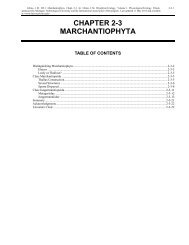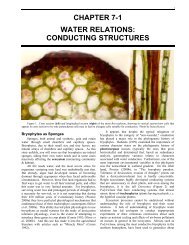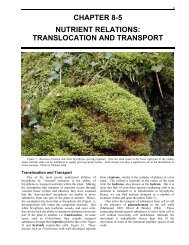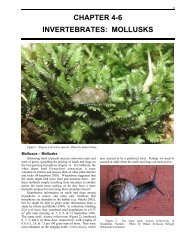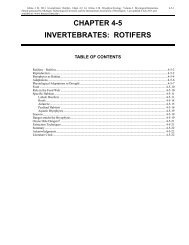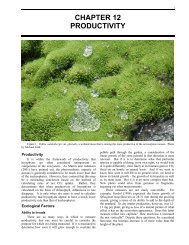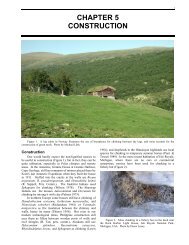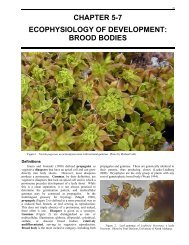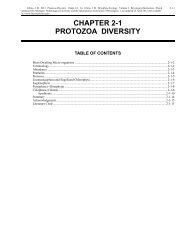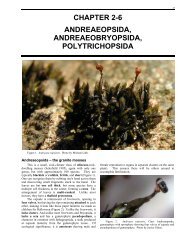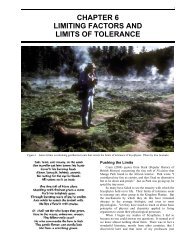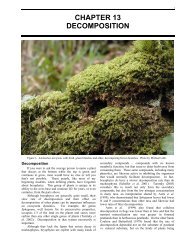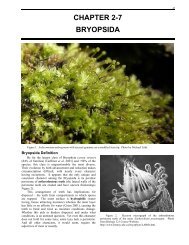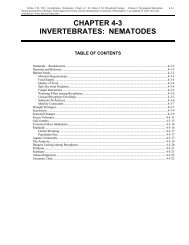Chapter 4-5: Adaptive Strategies - Bryophyte Ecology
Chapter 4-5: Adaptive Strategies - Bryophyte Ecology
Chapter 4-5: Adaptive Strategies - Bryophyte Ecology
You also want an ePaper? Increase the reach of your titles
YUMPU automatically turns print PDFs into web optimized ePapers that Google loves.
44 <strong>Chapter</strong> 4-5: <strong>Adaptive</strong> <strong>Strategies</strong>: Growth and Life Forms<br />
Mägdefrau Life Forms<br />
Annuals – pioneers; no vegetative shoots remain to carry on a<br />
second year; Buxbaumia (Figure 5), Diphyscium, Ephemerum<br />
(Figure 12a), Phascum, Riccia<br />
Short turfs – open mineral soils and rocks; regenerative shoots;<br />
form spreading turfs for only a few years; Barbula (Figure<br />
12b), Ceratodon, Didymodon, Marsupella<br />
Tall Turfs – forest floors in temperate zones; can conduct water<br />
internally; very tall; persist by regenerative shoots;<br />
Bartramiaceae, Dicranaceae, Polytrichaceae (Figure 12c),<br />
Drepanocladus, Herbertus, Sphagnum, Tomenthypnum<br />
Cushions – rocks, bark, Arctic, Antarctic, alpine; usually high<br />
light; grow upward and sideways; hemispherical; persistent for<br />
many years; Andreaea, Grimmia, Leucobryum (Figure 13),<br />
Orthotrichum, Plagiopus, no liverworts<br />
Mats – rocks, bark, [on leaves (epiphyllous) in tropics];<br />
plagiotropic and persistent for a number of years;<br />
Lejeuneaceae, most Marchantiaceae, Homalothecium,<br />
Lophocolea, Plagiothecium (Figure 12d), Radula<br />
Wefts – forest floor of temperate zone; hold considerable<br />
capillary water; grow loosely and easy to remove from<br />
substrate; new layer grows each year; Brachytheciaceae,<br />
Hylocomiaceae (Figure 6), Bazzania, Ptilidium, Thuidium,<br />
Trichocolea<br />
Pendants – epiphytes, especially in tropical cloud forests; long<br />
main stem with short side branches; Meteoriaceae (Figure<br />
12e), Phyllogoniaceae, some tropical Frullania<br />
Tails – on trees and rocks, shade-loving; radially leafed, creeping,<br />
shoots stand away from substrate; Cyathophorum, Leucodon<br />
(Figure 4d), Spiridens, some tropical Plagiochila<br />
Fans – on vertical substrate, usually where there is lots of rain;<br />
creeping, with branches in one plane and leaves usually flat;<br />
Neckeraceae (Figure 12f), Pterobryaceae, Thamnobryum,<br />
some Plagiochila<br />
Dendroids – on ground, usually moist; main stem with tuft of<br />
branches at top; Climacium, Hypnodendron, Hypopterygium,<br />
Leucolepis, Pleuroziopsis (Figure 12g), Symphogyna<br />
hymenophyllum<br />
Streamer – long, floating stems in streams and lakes; Fontinalis<br />
(Figure 12h)<br />
Environmental Influences on Life Form<br />
These eleven forms may be further divided, as<br />
suggested by Horikawa and Ando (1952). As Mägdefrau<br />
(1982) points out, light and water are the predominant<br />
influences on life forms. Crowded shoots with dense<br />
foliage facilitate water movement and retention in areas<br />
with sufficient soil water, thus favoring tall turfs. Mats,<br />
wefts, tails, and fans, on the other hand, are unable to<br />
obtain water by capillary action, but depend on the<br />
capillary spaces to retain water and extend their periods of<br />
activity. Pendants (Figure 12e) are like laundry on the<br />
clothesline and are particularly susceptible to drying; hence<br />
they live in places with considerable rainfall or fog,<br />
assumedly directing the water to the growing tip.<br />
Mägdefrau (1982) cites his observations on mosses near<br />
waterfalls to support this assumption.<br />
The cushion life form (Figure 13) is highly adapted for<br />
water conservation. Proctor (1980) found that the laminar<br />
flow patterns over moss cushions were consistent with the<br />
measured loss of water from surfaces of varying degrees of<br />
roughness. Water loss increased rapidly beyond a critical<br />
wind speed, at which the surface irregularities of the<br />
cushion could be related to boundary-layer thickness. The<br />
thickness of this boundary layer determines the rate of<br />
water loss, with thick layers reducing evaporation. Even<br />
cushions have turbulent flow as opposed to laminar flow<br />
(Rice et al. 2001), and the more deeply the air penetrates<br />
into the moss canopy, the more turbulent that flow and the<br />
greater the evaporation. Among the growth forms, we<br />
would expect cushions to have the least turbulence, with<br />
wefts and turfs creating more (Figure 14). Surface<br />
roughness increases conductance (Rice et al. 2001).<br />
However, Proctor (1980) found that hair-points of the<br />
leaves that project above the cushion surface reduce<br />
boundary layer conductance, for example, by about 20-35%<br />
in Syntrichia intermedia and Grimmia pulvinata (Figure<br />
10),<br />
hence serving as an adaptation to reduce water loss.<br />
Figure 13. Cushions of Leucobryum glaucum in a mixed<br />
hardwood forest in the Keweenaw Peninsula of Michigan, USA.<br />
Photo by Janice Glime.<br />
Figure 14. Diagram indicating turbulence and boundary<br />
layer as might be found above the irregular surface of a moss<br />
weft. Having all stems at the same height, as in a cushion, would<br />
reduce the turbulence. Drawing by Margaret Minahan.<br />
Rice et al. (2001) have used wind tunnel experiments<br />
to examine effects of architectural features on boundary<br />
layer thickness and subsequent water balance of<br />
bryophytes. Using evaporation rates of ethanol, they were<br />
able to assess differences among 11 taxa having a variety<br />
of canopy structures. They accounted for 91% of mass<br />
transfer of water loss using models based on surface<br />
structure. Even the seemingly smooth surface of cushions<br />
behaved as turbulent flow rather than laminar flow



